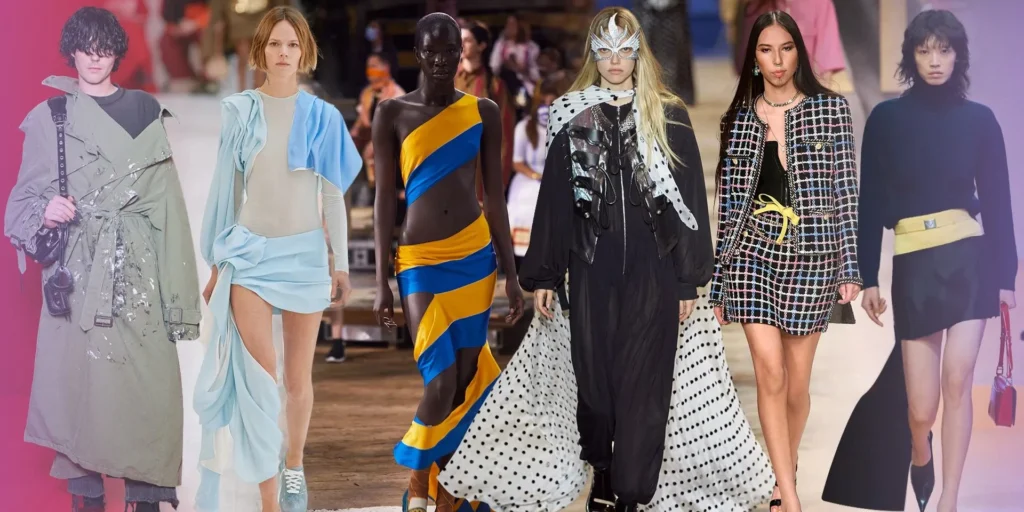In the epoch of the 1950s, amidst burgeoning affluence and the return of women, liberated during the tumult of the Second World War, a conservative milieu took root, accentuating tradition and the primacy of conventionality. This cultural zeitgeist found resonance in fashion, exacting a standard of impeccable attire, leaving no detail unattended. The exigencies of war had, in tandem, engendered the technical infrastructure for mass production, democratizing trends in fashion, as disseminated through periodicals, rendering them accessible to all.
THE COMMENCEMENT OF THE FIFTIES IN FASHION (1950-1952)
The outset of this era was indelibly stamped by the residual effects of war and a resurgence of conventional values. The industrial gains of wartime paved the way for the expansion of mass production and the integration of synthetic fabrics, which served as a counterbalance to the elegance of evening wear. Despite the post-war era of austerity, scarcity of textiles persisted, prompting a surge in the refurbishment of pre-owned garments.
RESPLENDENT ATTIRE—EVEN WITHIN DOMESTIC ENCLAVES
The aesthetic of the fifties was defined by refinement. Women, in particular, were enjoined not only to present themselves impeccably in public but also within the confines of their domicile. Luxuriant textiles such as velvet, tulle, and silk bedecked evening attire, while wool and cotton gained ascendancy in diurnal fashion.
THE VOGUE OF THE WASP WAIST AND BODICE—EXALTING THE HOURGLASS FORM
The adoption of tightly laced corsets to achieve the coveted wasp waist silhouette, popularized by luminaries such as Dior, was not uncommon. Initially met with resistance in the United States, the pursuit of sartorial perfection swiftly gained currency. Concurrently, the vogue for form-fitting dresses and hourglass contours, pioneered by Dior, reinvigorated the corsetry market. Additionally, undergarments played a pivotal role in sculpting the silhouette, with items such as waspies, girdles, and horsehair pads witnessing a surge in demand. Notably, the advent of the cathedral bra, boasting shaping underwires, achieved ubiquity, courtesy of luminaries like Marilyn Monroe and other screen icons.
Read more, click here to know about What Is Chic Fashion?
SARTORIAL ELEGANCE FOR THE OFFICE—THE ASCENDANCY OF SUITS
In response to the burgeoning cadre of white-collar professions, men favored somber, predominantly double-breasted suits in muted hues, characterized by broad shoulders and boxy silhouettes. With the relaxation of fabric constraints, trousers acquired greater fullness, oft adorned with lapels. Knickerbockers and leather shorts provided a modicum of variety. Punctilious grooming, complemented by meticulously coordinated accessories, was de rigueur. Women in the workforce commonly donned trim, snug-fitting waistcoats paired with loosely tailored jackets.
THE EMERGENCE OF THE NEW EDWARDIAN AESTHETIC—INFUSED WITH A HINT OF BOHEMIAN SPIRIT
Inaugurated in 1950 by Harper’s Bazaar, the New Edwardian aesthetic, characterized by slightly flared jackets, natural shoulder lines, and a more slender cut, heralded a departure from prevailing norms. This aesthetic was complemented by the inclusion of a bowler hat with a ruffled brim and a resplendent long black coat bedecked with a velvet collar.
NYLON—THE ASCENDANCY OF SYNTHETIC FIBERS
The post-war economic resurgence precipitated the rapid proliferation of synthetic materials such as polyester and rayon. Acrylic, triacetate, and spandex made significant inroads into the realm of fashion. Notably, nylon emerged as a ubiquitous choice, finding application in undergarments, nightwear, and iconic stockings, supplanting silk counterparts. Despite initial durability concerns, nylon stockings supplanted silk counterparts, although the former’s durability was initially wanting, necessitating a niche market for repair services, which persisted until the 1960s.
INFORMAL ATTIRE—THE APPEAL OF CORDUROY
Sporting jackets, often cut akin to contemporary suits, garnered favor, with checkered patterns enjoying particular vogue. Corduroy jackets, 49er jackets, and car coats gained traction in the United States, transcending associations with lumberjacks and surfers. Meanwhile, women favored capri pants, circle skirts, and off-the-shoulder blouses.
THE INTERSECTION OF EASTERN AND WESTERN FASHION—A CATALYST FOR IDENTITY EVOLUTION
The denouement of World War II witnessed the burgeoning independence of erstwhile colonies, precipitating an impetus to forge unique sartorial identities. This trend found expression in the fusion of Western tailoring with traditional accouterments such as the astrakhan, fez, or keffiyeh. In India, the Nehru-collar suit supplanted the sherwani in many quarters, while the Mao suit gained currency in hues of green, blue, and gray.
In conclusion, the 1950s were a pivotal epoch in the evolution of fashion, marked by a delicate balance between tradition and innovation. From the resurgence of conservative values to the democratization of trends through mass production, this era left an indelible mark on the sartorial landscape. Women’s fashion saw the rise of the iconic hourglass silhouette and the embrace of luxurious fabrics, while men’s attire transformed to accommodate the changing demands of the white-collar workforce.
The emergence of new aesthetics like the New Edwardian style added a touch of bohemian spirit to the fashion scene, while the proliferation of synthetic fibers revolutionized the industry. Informal attire flourished with the popularity of corduroy and casual jackets, reflecting a shift towards more relaxed fashion sensibilities. Furthermore, the intersection of Eastern and Western fashion signaled a broader cultural exchange and the evolution of unique sartorial identities around the globe. As we reflect on this rich tapestry of fashion history, it’s evident that each era leaves its distinct imprint on the collective consciousness of style. For those eager to delve deeper into the annals of fashion history, Chic Fist provides a comprehensive archive of trends and insights, ensuring that the legacy of past styles continues to inspire and inform contemporary fashion.




